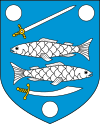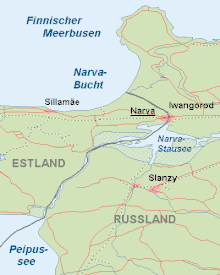Narva (city)
| Narva | |||
|
|||
| State : |
|
||
| Circle : |
|
||
| Founded : | 1345 | ||
| Coordinates : | 59 ° 22 ′ N , 28 ° 11 ′ E | ||
| Height : | 25 m | ||
| Area : | 84.54 km² | ||
| Residents : | 56,103 (January 1, 2018) | ||
| Population density : | 664 inhabitants per km² | ||
| Time zone : | EET (UTC + 2) | ||
| Telephone code : | (+372) 035 | ||
| Postal code : | 20001-21020 | ||
| Community type: | city | ||
| Mayor : | Aleksei Jevgrafov | ||
| Postal address : | Peetri pl. 5 20308 Narva |
||
| Website : | |||

|
|||
Narva ( German Narwa ; Russian Нарва ) is the third largest city in the Republic of Estonia , an important industrial city and the center of the Russian-speaking minority of Estonia, to which about 95% of the inhabitants of Narva belong.
geography
Narva is the easternmost city in Estonia. It lies on the border with Russia on the Narva River , which forms the border river here and flows north of the city into the Gulf of Finland in the Baltic Sea. Together with Ivangorod on the Russian side, Narva forms a twin city .
Since 2017, the city on the Estonian side has been completely enclosed by the newly founded municipality of Narva-Jõesuu .
history
Narva culture
Between 4600 and 4100 BC The Baltic lagoon culture , also known as the Narva culture , is widespread here. It is considered to be the substrate culture of the later western Baltic .
middle Ages
Due to its favorable location, Narva was an important trading center as early as the Middle Ages . The settlement is mentioned in the Novgorod Chronicle in 1171. In 1302 it received city rights. The Danes sold the area to the Teutonic Order in 1346 . Ivan III built in 1492 . on the eastern side of the Narva the fortress Ivangorod . The Livonian War led to the occupation of Narva by Russia in 1558. In 1581, Swedish rule began. With the closure of the Hanse Kontor Peterhof in Novgorod in 1494 by Tsar Ivan III. the importance of Narva for trade increased again.
Modern times
During the Great Northern War , the Battle of Narva took place here on November 30, 1700 , in which the Russian army under Peter I suffered a devastating defeat. After the reorganization of his troops, however, Peter conquered the city in 1704 after the siege of Narva and incorporated large areas of the Baltic and Karelia into the Russian Empire with the Peace of Nystad in 1721 .
In the 19th century Narva lost its importance as a port city and developed into a center of textile manufacturing . The Kreenholm company has played a significant role in the city for a long time. From 1918 to 1940 the city belonged to the Republic of Estonia, and after the annexation of Estonia by the Soviet Union from 1940 to 1991 to the Estonian SSR .
Narva was almost completely destroyed in World War II between 1941 and 1944. The historical buildings were usually not rebuilt. The cityscape today is characterized by apartment blocks with exposed brick facades that were built in Soviet times. During this time, many Russian immigrants came to the city, but workers from other Union republics were also settled for the Narva industrial plants, while the evacuated Estonian population was not allowed to return for a long time. Hence the today's high Russian-speaking population.
Narva and Ivangorod
After Ivangorod was founded on the other bank of the Narva in 1492, a close relationship developed between the two cities over many decades. During the period of state independence of the Republic of Estonia from 1918 to 1940, Ivangorod was also on Estonian territory, as the border with the former Soviet Union was further east. After the occupation of Estonia by the Soviet Union in 1940 and the establishment of the Estonian SSR , the Narva River became the border between the Union Republics of Estonia and Russia. With Estonia's renewed independence in 1991, a guarded border was established again, which has been the EU's external border since Estonia joined the European Union on May 1, 2004 .
Town twinning
-
 Karlskoga , Sweden
Karlskoga , Sweden -
 Tinglev , Denmark
Tinglev , Denmark
-
 Donetsk , Ukraine
Donetsk , Ukraine
-
 Lahti , Finland
Lahti , Finland
-
 Ivangorod , Russia
Ivangorod , Russia
-
 Parnu , Estonia
Parnu , Estonia
Culture and sights
Museums
- Narva Museum with extensive exhibition in the Hermannsfeste on the history of the city, fortress and region as well as the art gallery housed in a baroque old town building from the 18th century.
Buildings
- The Hermannsfeste ( Hermanni Linnus ), a fortress of the Teutonic Order restored after severe war damage , is located on the west bank of the Narva across from the Russian fortress Ivangorod . The historical exhibition of the Narva Museum is housed in the tower of the fortress. In the courtyard of the fortress is the last publicly exhibited monument to Lenin in the Baltic States , which was originally erected in the city center of Narva.
- The town hall was built during the Swedish rule from 1665 to 1671 according to a design by the architect Georg Teuffel from Lübeck in the style of Dutch classicism and was rebuilt as one of the few monuments in the old town area from 1960 to 1963 after severe war damage in 1944.
- The Russian Orthodox Resurrection Cathedral was built from 1890 to 1898 in the neo-Byzantine style.
- The Evangelical Lutheran Alexander Church was built in the form of an octagon with an octagonal tower 61 meters high in 1883/1884 in neo-Romanesque style and named after Tsar Alexander II, who was killed in an assassination attempt in 1881 . It was destroyed in 1944 and rebuilt in the post-war period, the bell tower was reconstructed in 2007/2008.
Parks
On the outskirts of Narva, directly on the border river Narwa , is the German war cemetery Narva , which was laid out by the German Wehrmacht in 1943 . It has been looked after and maintained by the Volksbund Deutsche Kriegsgräberfürsorge since the mid-1990s . The extensive facility, on which around 15,000 war dead rest and on which the dead are still being buried, was inaugurated on August 29, 1999. In Narva there was the Soviet POW camp 393 for German POWs of the Second World War. Seriously ill people were cared for in POW Hospital 1011 , Kiviõli .
Economy and Infrastructure
traffic
The most important trunk road from Tallinn to Saint Petersburg as well as the Tallinn – Narva railway , which is particularly important for freight traffic with Russia, run through Narva . Several pairs of trains run in passenger rail transport: Narva-Tallinn twice a day, Moscow -Narva-Tallinn once a day and Saint Petersburg-Narva-Tallinn. In addition, three times a week there is another pair of trains between Tallinn and Saint Petersburg, which stop in Narva. As everywhere in Estonia, bus transport has a larger share in passenger transport.
Established businesses
The textile company Kreenholm , founded in 1857 and now part of the Swedish Borås Wäfveri , plays an important role in Narva's economic life .
media

The newspaper Narva Postiljon is 5,000 copies, the local newspaper of the city. It is published once a week (on Saturday) in Estonian . It appears twice a week in Russian under the name Narvskaja Gazeta .
education
In Narva there is a branch of the University of Tartu , the Narva Kolledž , which mainly trains teachers. The language of instruction is mainly Russian . There is also a branch of the private Estonian Entrepreneurship University for Applied Sciences .
Personalities
sons and daughters of the town
|
|
People who worked in the place
- Otto von Uexküll († 1601), Swedish governor in Narva in 1599
literature
- Karsten Brüggemann (Ed.): Narva and the Baltic Sea Region. Contributions of the II. International Conference on Political and Cultural Relations between Russia and the Baltic Sea Region (Narva, May 1-3, 2003) = Narva and the Baltic sea region. Narva Kolledž, Narva 2004, ISBN 9985-4-0417-3
- Dirk-Gerd Erpenbeck, Enn Küng: Narvaer Citizens and Residents Book 1581–1704. Research Center East Central Europe, Dortmund 2000, ISBN 3-923293-63-1
- Dirk-Gerd Erpenbeck: Narvaer Bürger- and residents' book 1704-1840. AGoFF, Herne 2014, ISBN 978-3-939271-06-2
- Heinrich J. Hansen: History of the city of Narva . Heinrich Laakmann, 1858, digitized
- Anton Weiss-Wendt: Must-valge linn / black and white city. Vana-Narva fotoajalugu / Photo story Narva. Catalog / Catalog. Tallinn, 1997
Web links
- Official website of the city
- Narvaer College of the University of Tartu
- The Narva Museum (Estonian, Russian, English)
- Narva in the Topographia Electoratus Brandenburgici et Ducatus Pomeraniae ( Matthäus Merian ) on Wikisource
- City view (unfolded folding picture in the appendix) according to JB v. Fischer: Attempt at a natural history of Livonia . 2nd Edition. Koenigsberg 1791
- Narva 2012. Art-Project (photo art and painting)
Individual evidence
- ↑ Statistics Estonia: Population by sex, age and place of residence after the 2017 administrative reform, 1 January. Retrieved February 17, 2019 .
- ↑ Marija Gimbutas: The ethnogenesis of the European Indo-Europeans. Innsbruck, Inst. F. Linguistics d. Univ., 1992
- ↑ buildings in Narva on estland.com
- ↑ Erich Maschke (ed.): On the history of the German prisoners of war of the Second World War. Verlag Ernst and Werner Gieseking, Bielefeld 1962–1977.
- ↑ Study Centers: Narva ( Memento from February 13, 2013 in the web archive archive.today )











